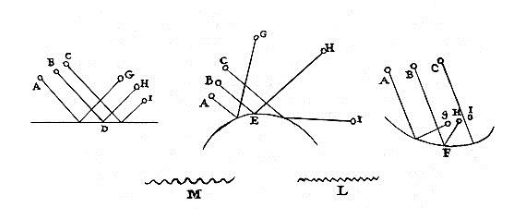The Linear Movement of Light
Table of Contents
Actual Movement Versus the Inclination to Move
It is necessary to distinguish between:
- actual movement and
- the inclination to move.

The inclination to move is expressed as the grape juice at C tending towards B and A without actually moving towards them.
The actual movement is expressed as the grape juice at C actually moving towards B and A but are hindered by the grape clusters that are between them.
In the same way, we are concerned with the actual movement of luminous bodies more than their theoretical movement. This is why you must think of the rays of this light as mere lines along which this movement-action tends.
It follows that there is an infinity of such rays that come from all points of the luminous bodies, towards all points which they shine on.
There is an infinity of straight lines, along with their actions, coming from surface CDE going towards A and B without hindering each other.
Thus, all the parts of the fire-aether that are touched by the side of the Sun facing us tend in a straight line towards our eyes when we open them.
3. Light as a Ball (Particle)
Light rays are always straight when they pass through a single transparent body that is uniform throughout.
Reflection as Bouncing Off
However, when they encounter other bodies, they are deflected or weakened by them. This is similar to how a ball thrown into the air is affected by the objects that it encounters. Those encountered bodies can be either soft, hard, or liquid.
- If they are soft, they completely stop and absorb its motion.
- If they are hard, they reflect it in various ways without stopping it.
The surfaces of the bodies that they encounter are either:
- flat and uniform or
- curved in various ways
These can consist of:
- multiple diverse parts, each of which is enough to be united, or
- multiple diverse angles or peaks
- parts that are harder than others
- parts that move in a thousand different ways.
Balls have 2 movements:
- One that takes it from point A to point B
This is its simple and ordinary movement
- One that makes it rotate around its own center
The speed of this rotational movement can have multiple different proportions with that of its simple movement.
When multiple balls, coming from the same side, encounter
- a flat body, they reflect equally and in the same order. They keep the same distance between them after bouncing off.
- a body that is curved inward or outward, they come closer or go farther away from each other according to this curvature.

The balls A, B, C encounter the surfaces of the bodies D, E, F and are reflected towards G, H, I.
If these balls encounter an uneven surface, like L or M, they reflect towards diverse sides, each one according to the surface that it touches.
When the inequality of its motion is only in them being bent in various ways, then they do not change that motion.
Refraction as Bending
But the surfaces can also cause them to gain a circular motion in various proportions.
Those who play tennis experience this. When their ball hits their racket obliquely, the ball curls.
A curling ball that hits water changes its course after entering it.

For example, a ball that enters B from A will be diverted to I.
Black bodies dampen the rays of light and take away all their force.
Reflective bodies reflect light by having their whole surfaces polished.
- Some reflect these rays without changing their action, leading to white light.
- Some reflect these rays by adding a curled motion, leading to red, yellow, blue or some color of light.
Each of these colors has a nature. But that is beyond the scope of this work.
The rays, which fall on bodies that are colored and not polished, are usually reflected on all sides, even if they come from only one side.

For example, light that falls on the white body AB come only from the torch C.
The light reflects on all sides. Wherever the eye is placed, light comes from this surface AB towards it, such as when it is at D.
If AB is very thin like paper, the light passes through it. If the eye is at E, then the paper will still reflect some of the light to E.
The rays also bend just like a ball that obliquely hits the surface of a transparent body. This bending is called refraction.